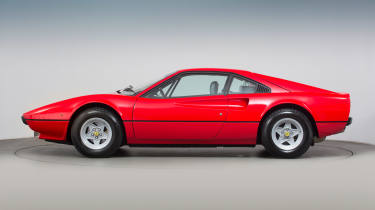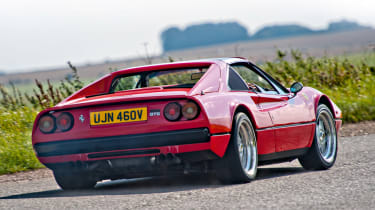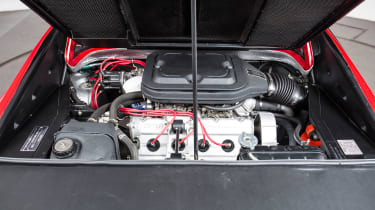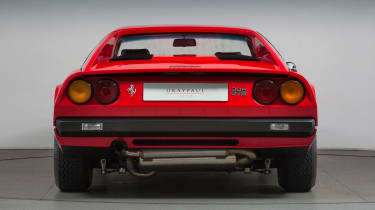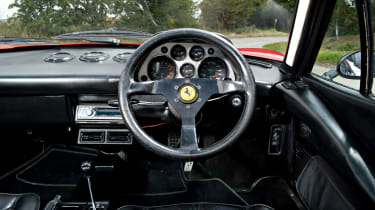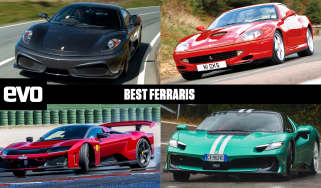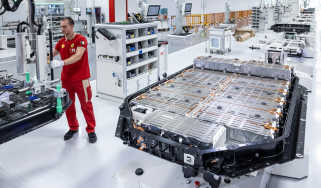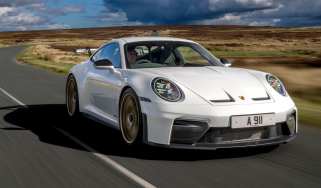Ferrari 308 GTB/GTS: history, specs and buying guide
With a little help from a certain private eye, the 308 GTB/GTS would become Ferrari’s best-selling model. Here’s our essential guide
In the early days, Enzo Ferrari often declared that his road cars would only ever have 12-cylinder engines. That was why, when the company first started producing models with V6s and V8s, they were badged as Dinos. Or at least they were when they left the factory; owners and sometimes even importers would add Ferrari badges – once they were away from the gaze of Maranello…
So first came the V6-engined Dino 206 and 246 GT, joined a few years later by the V8-engined Dino 308 GT4 2+2. A sub-brand, we’d call it today. The 308 GT4 was a good car, but its sharp-edged Bertone lines left many pining for the curves of the earlier, Pininfarina-penned Dino. Happily, when it came to the 246’s replacement, Ferrari went back to its preferred styling house. The result, revealed in 1975, was the 308 GTB. Designed by the masterful Leonardo Fioravanti, with obvious nods to the 246 in the curving wing-tops and sculpted air intakes, but also a clear relationship to Fioravanti’s clean-lined and then-recently launched Berlinetta Boxer, it was at once nostalgic and achingly modern.
The transversely mounted 252bhp four-cam 3-litre V8 and five-speed transmission were taken pretty much straight from the 308 GT4 2+2. Transplanted into the lighter and more slippery GTB – early cars were skinned in glassfibre, and the GTB was the first Ferrari to benefit from being developed in Pininfarina’s wind tunnel – the result was 0-60mph in around 6.5sec and a top speed of over 150mph: Paul Frère recorded 154mph when he tested a GTB for Road & Track magazine.
> Ferrari Dinos go head-to-head – 246 GT v 206 GT
Despite having fewer than Enzo’s requisite 12 cylinders, the 308 GTB was also badged and marketed as a Ferrari – a victory for the money men at parent company Fiat, no doubt, but one warmly embraced by customers. The GTB not only looked terrific; it had excellent performance, was barely two-thirds of the price of a Berlinetta Boxer, and it had a Ferrari badge on the nose. No wonder it sold like hot cakes.
In fact it soon became Ferrari’s biggest-selling model thus far – and would hold that title until the 360 Modena eventually surpassed it in the early Noughties. Between 1975 and 1985, more than 12,000 were sold in a combination of GTB, GTS (targa roof) and QV (quattrovalvole in Italian, so four valves per cylinder) variants. And when 308 evolved into the slightly larger-engined 328 in 1985, a further 7412 units were sold before Ferrari finally called time in 1988. So one thing you’re not short of is choice.
Particularly collectable in recent times have been the early cars, bodied in glassfibre – or vetroresina in Italian – such as the one in the photos here. Just 808 were produced before Ferrari switched to steel bodies in June 1977 and the weight difference is marked. The GRP-bodied car weighed only 1090kg dry, or about 1250kg with fluids; the switch to steel was reckoned to add 150kg, taking the total to c1400kg.
Not only were they lighter, but these cars featured the V8 engine at its most potent, with a quartet of twin-choke Webers and dry-sump lubrication. European cars had the full 252bhp (255PS); those for the US market were detuned to comply with tougher emissions regs, which left them 15bhp down at 237bhp. US cars also had a wet sump, as per the 308 GT4, though all GTBs had that from 1981 onwards.
The 308 GTB was never quite as fierce again. Fuel injection replaced carburettors in all markets from 1980, and though it made the 308 cleaner and less temperamental, peak power dropped to 211bhp on European cars and a miserable 202bhp on federalised models. The arrival of the QV in 1982 restored most of the lost horses: peak power was back up to 237bhp in Europe, 232bhp in the US. But if you want the leanest, keenest 308, then the earlier the better.
That's certainly the view of Russell Smith, service manager at independent specialists Bob Houghton Ltd. ‘The early carburettor car is probably the one to have,’ he says. ‘Yes, they’re slightly more temperamental and they need regular tuning, but they are the purest and the most powerful. The first is always the best.
> Ferrari 360 Modena: history, specs and buying guide
‘Generally, though, any 308 – or 328 – is a good bet. It’s a simple car by modern Ferrari standards; generally reliable, relatively easy to work on, and good value. Provided they haven’t been crashed or badly treated, they’re relatively cheap to run in Ferrari terms.’
The 3-litre V8 is a robust engine that, properly maintained and sensitively driven (no high revs from cold), is quite capable of reaching high mileages without requiring a rebuild. ‘We used to look after one that had done over 100,000 miles,’ Russell tells us, ‘still on its original engine, didn’t seem to burn any oil.’
Look carefully through the history, though – these engines have shimmed valve clearances, which are supposed to be checked every 12,500 miles. When the car was new, service intervals were 6250 miles, but these days specialists advise an annual service – even if a car is doing just a few hundred miles a year – with the cambelts changed every other service.
Bob Houghton Ltd charges around £900 for a basic service – add another £750 if you’re having the belts changed (all figures including VAT). Don’t assume that an official Ferrari dealer will charge a lot more than a top independent. Those figures are pretty much in line with what Classiche-certified Graypaul Nottingham currently charges, as part of a drive to attract more owners of classic Ferraris. Indeed, it’s currently rebuilding a 308 engine.
Graypaul’s Dean Pallett confirms that a carburettor car will generally require more maintenance. ‘We check the emissions and if they’re way out or there’s a misfire, we may have to strip the carbs down and clean the jets and so forth, then balance them up again. Generally problems seem to start when the car’s not used much; the less you use them, the more troublesome they tend to be.’
Find used Ferraris on BuyaCar...
Cam seals can be prone to leaking. ‘If it’s a small leak people tend to put up with it,’ says Dean, ‘because it’s a fairly big job – probably a couple of grand.’ The good news is that this and most other jobs can be done without taking the engine out. And that includes the biennial cambelt change. Whereas some mid-engined cars require you to take the engine out to change the belts or chains, with the 308 GTB you can get access simply by removing the right rear wheelarch liner. It’s a similar story with the clutch, which is accessed from the left-hand side. ‘It’s things like this that make them relatively cheap to maintain,’ says Russell Smith. Having a new clutch fitted will cost around £750, so again, nothing too scary.
The transmission is mounted below and to the rear of the bottom of the engine and takes the form of a five-speed all-synchro gearbox, which drives through a clutch-type limited-slip differential. Expect the gearbox to feel notchy when cold and to baulk slightly when going into second, but once warm it should be fine.
Russell recommends changing the gearbox oil every four or five years. Cars that spend a lot of time standing without being driven, particularly in a damp atmosphere, can experience problems with the clutch plates in the diff suffering corrosion and seizing. ‘It doesn’t happen very often, but it’s a good idea to listen out for any untoward noises from the diff,’ says Russell. ‘It’s the same old story – they like to be used.’
The rest of the mechanical package is similarly straightforward; double wishbones with coil springs over telescopic dampers at all four corners, vented disc brakes all-round, and unassisted rack-and-pinion steering.
One potentially large bill is to replace the suspension bushes. ‘If there’s play, they’re probably perished,’ says Russell. Many owners take the opportunity to have the suspension arms rust-proofed and repainted. ‘Just replacing the bushes is going to be something like three grand,’ says Dean. ‘Have everything stripped and powder-coated as well, and you’re looking at around ten.’
> Ferrari 550 Maranello: history, specs and used review
‘Be wary of excessive shimming on the suspension forks,’ adds Russell. ‘It may indicate it’s had a hit and someone’s packed it out with extra shims to get the wheels pointing in the same direction.’
If you’re looking at a 328, it should have been subject to a recall – technically a ‘service measure’ – to replace the front suspension mounting forks with thicker-gauge steel. ‘It would be worth checking with a Ferrari dealer,’ says Russell. ‘Failure of these forks can lead to collapse of the front suspension, so it’s well worth the research time.’
The handbrake calipers can stick or fail, requiring a rebuild. Also check the tyres for age as well as condition. They should ideally be replaced when they’re ten years old so look for the date stamp. The good news is that the original-fitment Michelin XWX is still readily available, as are all service items.
But while mechanical parts are easy to source, things like light units and trim are trickier, so examine them all carefully.Also check that the air-con blows cold. The early R12 system can no longer be regassed, and conversion to the later system costs around £1000. ‘If it’s not working, I’d be suspicious,’ says Dean.
For most buyers, the biggest area of concern is the bodywork and the underlying structure. It is, after all, an Italian car from a time when corrosion issues were the stuff of legend. In fact, 308s are no worse than most of the period and better than many. Also note that cars built after January 1984 had a corrosion-reducing Zincrox coating applied to the steel panels.
All variants are supported by a tubular steel frame – again shared in most part with the GT4 2+2 – with some sheet metal elements including a riveted aluminium floor and a welded sheet-steel rear bulkhead. ‘They’re old Italian cars and the main thing you look out for is rust, particularly on the lower panels of the car,’ says Russell. ‘The front of the sills is particularly prone where it meets the bottom of the front wing because of all the muck that collects there.
‘Also examine the bottoms of the doors and run your fingers carefully along the belt-line that runs all round the car – if rust is coming through you’ll feel it here, rough and uneven and bubbling.’
The structural tubular steel frame underneath is largely protected by undertrays, so tends not to give too many problems. The frame at the front, where the battery sits, and around the engine, is more visible and should give a good idea to the general condition of the structure. If you find corrosion there, further investigation is required.
Obviously GRP doesn’t rust, but the early cars seem to have more corrosion issues under the skin. ‘I don’t think they’d worked out drainage, so water tends to collect behind the panels,’ says Russell. ‘So you tend to find more rust in the sills, for example, which are still steel. Pay them plenty of attention.’
Dean Pallett agrees: ‘The glassfibre cars tend to be more trouble because you can’t see a lot of the structure underneath the glassfibre and when you take the body off you can find the structure has rotted away in places. The thing is, you only know when you get to the stage of a restoration.’
As well as condition, it’s mileage and provenance that determine values. The GTS, with its lift-out targa roof panel, is the most numerous and the most affordable, with presentable examples starting at around £60k. ‘Don’t expect it to be water-tight,’ is Russell’s word of caution for those wishing to play out their Magnum PI fantasies. ‘If it’s a GTS, keep it in the garage and use the top only in emergencies! You also tend to get more rattles and squeaks because they flex that much more.’ As is often the case, the Berlinetta is the purist’s choice.
High-mileage steel-bodied GTBs start at around £75k, but £85k-£95k is probably a more realistic budget to bag a decent one. Steel-bodied dry-sump carburettor GTBs are £100k-plus, but glassfibre-bodied cars are by far the most sought-after – because of their lightness and performance, but also because of their rarity, with just 154 right-hand-drive examples. Expect to pay £150k-plus for a good one, up to £180k for the very best. ‘It’s like the difference between an alloy 275 and a steel 275,’ says Russell.
A real novelty, should you find one, is the 2-litre version built chiefly for the Italian market, where tax laws penalised larger engines. In turbocharged form, these are a bit of a hoot – ‘almost like a mini F40 when the turbo kicks in’ is how Russell describes them – and, given the trend for downsized, turbocharged engines, rather ahead of their time!
> Ferrari F40 – review, history, prices and specs
Ferrari 308 GTB ‘Vetroresina’
| Engine | V8, 2926c |
| Max power | 252bhp @ 7700rpm |
| Max torque | 209lb ft @ 5000rpm |
| Transmission | Five-speed manual, rear drive, limited-slip differential |
| Suspension | Double wishbones, coil springs, telescopic dampers, anti-roll bar |
| Brakes | Vented discs, 272mm front, 277mm rear |
| Wheels | 7.5 x 14in front and rear |
| Tyres | 205/70 VR14 front and rear |
| Weight | c1250kg |
| Power to weight | 205bhp/ton |
| 0-60mph | 6.7sec (claimed) |
| Top speed | 157mph (claimed) |
| Price when new | c£30,000 |
| Values today | £150,000+ |
What they said at the time
‘The smaller Ferrari’s performance is utterly deceptive, with smoothness and absence of fuss from the engine compartment that completely belie the car’s performance. There is no dramatic unleashing of power as the engine gets “on the cam”, just a smooth flow from, say, 3000rpm to the 7700rpm red line. The tachometer is certainly not just a styling item, for there is no sign of the engine running short of breath and no change in the engine note to tell you to change up.
At lower speeds, gear whine, probably from the primary drive, is quite noticeable but it disappears when the speed rises and wind, engine and road noise increase, though they never reach a tiring level and are lower than in the Dino 246 GT.
I was lucky to be able to take advantage of Ferrari’s own Misano test track, just outside the Maranello factory. The circuit was very hard on the brakes, which were undisturbed by ten consecutive high-speed laps. The general handling of the Michelin XWX-equipped car is understeer. It is definitely more pronounced than in a Boxer, with which I also did several laps, but whereas the Boxer hardly changes attitude at all if the accelerator is lifted in a corner (in my opinion this is not the ideal behaviour), the 308 reacts to the manoeuvre by gently closing its line. Coming out of the bend, the tail can be forced around under power in an easily controlled drift, allowing full throttle quite early. Fast bends are really the 308 GTB’s element, however, and they can be taken in a full four-wheel drift with a feeling of utter stability.
The excellent handling was confirmed when the car was taken out on the autostrada and to winding mountain roads in the Appenine. At speed it feels dead stable and its behaviour on 140mph bends suggests that the front spoiler does its job of keeping the front wheels firmly down on the tarmac, while the mountain roads indicated that even bad bumps in corners do not throw the Ferrari seriously out of line. What these roads also revealed is how comfortable the suspension really is. Its travel is quite surprisingly long for such a low-built car. This is one of the biggest advances made, compared with the 246 GT. It is this sort of advancement that makes the 308 GTB the most charming car to come from Ferrari.’ – Paul Frère, Road & Track, March ’76
This feature was first published in Enzo issue 4.
